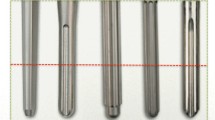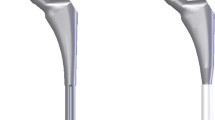Abstract
Permanent secondary stability of the uncemented femoral stem of hip prostheses can only be achieved once primary rotational and axial stability has been ensured. Rotational stability means that the stem is resistant to the articular forces that induce rotation around the implant’s longitudinal axis. The 10-year survival rates of two uncemented conical shaped stems with decisively different proximal shapes were significantly different (Schenker SK 63.9%, Zweymüller SL 97.0%). The shapes were analyzed biomechanically by testing rotational stability in a silicone model. A reduction in the mediolateral height of the metaphyseal part by one-third led to a 20% smaller angle of ascent (P < 0.01), which indicated lower resistance. The proximally broader (mediolateral) prosthesis therefore proved to have better rotational stability. The study confirms that aseptic stem loosening is attributable to the design of the proximal part of the prosthesis.
Similar content being viewed by others
Author information
Authors and Affiliations
Additional information
Received: 24 June 2000
Rights and permissions
About this article
Cite this article
Effenberger, H., Heiland, A., Ramsauer, T. et al. A model for assessing the rotational stability of uncemented femoral implants. Arch Orth Traum Surg 121, 60–64 (2001). https://doi.org/10.1007/s004020000215
Issue Date:
DOI: https://doi.org/10.1007/s004020000215




